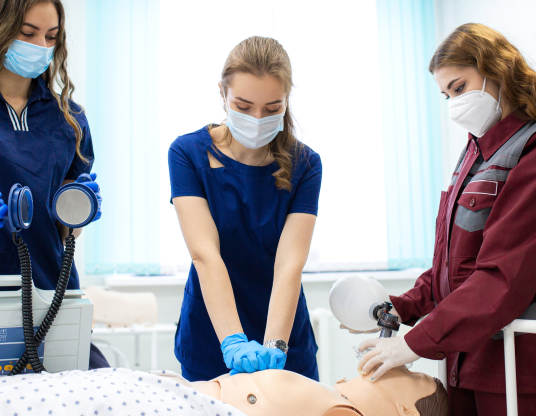Chapter 7: 2-Rescuer CPR And Bag-Mask
When you’re not alone in an emergency, CPR becomes a shared effort. In this part of your Online CPR/AED Course, you’ll learn how two people can work together to deliver high-quality Cardiopulmonary Resuscitation (CPR) and how to use a bag-mask device safely and effectively. Let’s break it down.
Working Together in 2-Rescuer CPR
Rescuer 1 – Compressions
This person starts compressions right away and stays positioned at the victim’s side.
- Press firmly in the center of the chest—at least 2 inches deep, but no more than 2.4 inches.
- Keep a steady pace of 100 to 120 compressions per minute.
- Use a rhythm of 30 compressions followed by 2 breaths.
- Let the chest rise completely after each push.
- Trade places with the second rescuer every 2 minutes or after 5 cycles to prevent fatigue.
Rescuer 2 – Airway & Breaths
The second person handles the breathing support and calls for emergency help.
- Call 9-1-1 and grab the Automated External Defibrillator (AED).
- Open the airway and be ready to deliver breaths using a bag-mask device.
- After every 30 compressions, give 2 breaths.
- Encourage Rescuer 1 to keep up strong, effective compressions.
- If more rescuers arrive, they can step in to help with the AED or bag-mask ventilation.
How to Use a Bag-Mask
A bag-mask device includes a self-inflating bag connected to a face mask. You’ll usually find one in hospitals or emergency kits, and it’s often used during 2-rescuer CPR. While effective, it’s also tricky—using it correctly takes practice.
Here’s how to do it correctly:
- Pick a mask that fits snugly over the patient’s nose and mouth.
- Don’t press the mask into the face—lift the patient’s face into the mask instead to form a tight seal.
- Connect the mask to the bag and attach the bag to high-flow oxygen (15 liters per minute). Make sure the bag is fully inflated.
- Open the airway using the head-tilt, chin-lift technique.
- Give 2 slow breaths, each lasting about 1 second.
- Watch closely—if the chest doesn’t rise and fall, something’s off. Check the seal, clear any obstructions, and confirm the airway is open.
This part of your CPR Certification helps prepare you to work as part of a team. When every second matters, knowing how to share the load and use the right tools can make all the difference.
